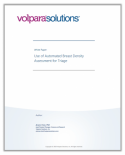Personalized screening recognizes that every woman is different, with varied mammographic sensitivity and risk of developing breast cancer.
Breast density is a known risk factor and commonly used in triage for supplemental screening. The practical question becomes how best to implement programs for women at high risk of breast cancer.
Our latest white paper explores how using automated volumetric breast density assessment makes triage more precise and eases the transition to personalized screening.
Visual vs. Automated Assessment
| Visual | Automated |
|
Visual assessment relies on subjective human judgment, and thus has natural limitations: |
Volpara®Density™ software is objective, consistent, and repeatable: |
| Studies have shown substantial disagreement between radiologists | Automatically assesses the volumetric breast density percentage (VBD%) of each mammogram on a continuous scale — typical volumetric breast density range is 2-35% |
| Reader experience level influences density assessment | Differentiates each woman on a continuum of density—whether her density is a “high ‘b’” or a “low ‘c’” |
| Vendor image processing algorithms can affect the visual impression of breast density |
Provides a patient-specific VBD value that helps the radiologist understand the sensitivity of each mammogram and personalize screening with supplemental imaging that accommodates differences in breast density |
Recognizing the continuum’s impact on risk, VolparaDensity software is the only automated, volumetric density-assessment software to have been validated in the Tyrer-Cuzick v8 Breast Cancer Risk Model.

